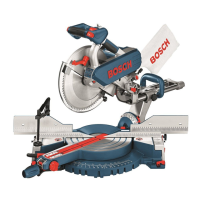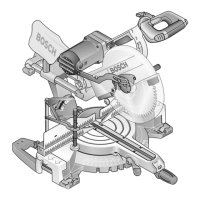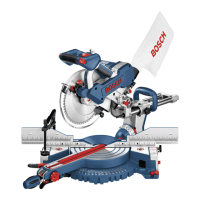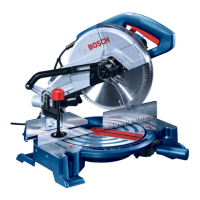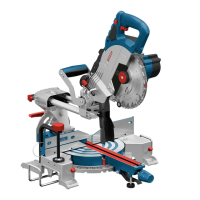English–151 609 929 F67 • (04.10) PS
Checking and Adjusting Basic Adjustment
Before all work on the machine, pull the mains
plug.
To ensure precise cuts, the basic adjustment must be
checked and adjusted as necessary after intensive us#
age.
Bevel Angle 0° (Vertical)
Place the electro#tool in the transport position.
Rotate the saw table 18 to the detent 17 for 0°. The le#
ver 15 must audibly engage in the detent.
Checking: (see Figure
)
Place a combination square set to 90° on the saw ta#
ble 18. The leg of the square must be flush with the
saw blade over its entire length.
Adjusting: (see Figure
)
Loosen the clamping handle 16. Loosen the bolts 60
and 61 with the open#ended spanner 3 (SW 10) pro#
vided. Loosen the adjustment screw 62 (approx. 3
turns) with the socket spanner 35 (SW 4) provided.
Screw the adjustment bolt 59 (SW 10) in or out far
enough until the leg of the protractor is flush with the
saw blade over its entire length.
Retighten the clamping handle 16. Retighten first the
adjustment screw 62 and then the bolt 60 and 61.
In case the angle indicators 24 and 33 are not in a line
with the 0° mark of the scale 32 after the adjustment,
loosen the attachment screws of the angle indicators
with the Phillips screwdriver 35 provided and align the
angle indicators along the 0° mark.
Left Bevel Angle 45° (Vertical)
Place the machine in the working position.
Rotate the saw table 18 to the notch 17 for 0°. Loosen
the clamping handle 16. Swing the tool arm with the
handle 7 to the left to the tool arm stop.
Checking: (see Figure
)
Set the combination square to 45° and place it on the
saw table 18. The leg of the square must be flush with
the saw blade over its entire length.
Adjusting: (see Figure
)
Screw the adjustment bolt 63 (SW 10) in or out far
enough so that the leg of the protractor is flush with the
saw blade over its entire length.
Retighten the clamping handle 16.
In case the angle indicators 24 and 33 are not in a line
with the 45° mark on the scale 32 after the adjustment,
first recheck the 0° adjustments for the bevel angle
and the angle indicator. Then repeat the adjustment
for the 45° bevel angle.
Clamping Action of the Clamping Handle for
the Vertical Bevel Angle
(also see Figure )
Loosen the clamping handle 16.
Adjusting:
Turn the adjustment bolt 64 with the open#ended
spanner 3 (SW 17) counter#clockwise to reduce the
clamping action or clockwise to increase the clamping
action.
Set a vertical bevel angle, tighten the clamping handle
16 and check if the desired clamping action is
achieved.
The clamping force must securely hold the tool arm in
any vertical bevel angle position.
Clamping Action of the Handle Clamp
(see Figure
)
Open the clamp 5.
Adjusting:
Turn the adjustment screws 65 with the Allen key 2
(SW 1.5) counter#clockwise to reduce the clamping
action or clockwise to increase the clamping action.
Always adjust the two screws to the same height.
Close the clamp 5 and check whether the desired
clamping action is achieved.
Angle Indicator (Horizontal)
(see Figure
)
Place the machine in the working position.
Rotate the saw table 18 to the detent 17 for 0°.
Checking:
The angle indicator 66 must be in alignment with the
0° mark of the scale 40.
Adjusting:
Loosen the attachment screw of the angle indicator
with the Phillips screwdriver 35 provided and align the
angle indicator along the 0° mark.
Retighten the attachment screw.
V1
V2
W1
W2
W2
X
Y
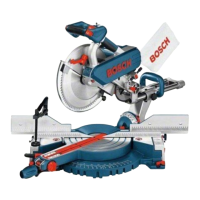
